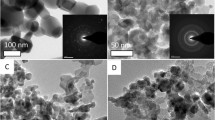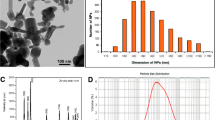Abstract
Nano zinc oxide (nZnO) is increasingly used in sunscreen products, with high potential of being released directly into marine environments. This study primarily aimed to characterize the aggregate size and solubility of nZnO and bulk ZnO, and to assess their toxicities towards five selected marine organisms. Chemical characterization showed that nZnO formed larger aggregates in seawater than ZnO, while nZnO had a higher solubility in seawater (3.7 mg L−1) than that of ZnO (1.6 mg L−1). Acute tests were conducted using the marine diatoms Skeletonema costatum and Thalassiosia pseudonana, the crustaceans Tigriopus japonicus and Elasmopus rapax, and the medaka fish Oryzias melastigma. In general, nZnO was more toxic towards algae than ZnO, but relatively less toxic towards crustaceans and fish. The toxicity of nZnO could be mainly attributed to dissolved Zn2+ ions. Furthermore, molecular biomarkers including superoxide dismutase (SOD), metallothionein (MT) and heat shock protein 70 (HSP70) were employed to assess the sublethal toxicities of the test chemicals to O. melastigma. Although SOD and MT expressions were not significantly increased in nZnO-treated medaka compared to the controls, exposure to ZnO caused a significant up-regulation of SOD and MT. HSP70 was increased two to fourfold in all treatments indicating that there were probably other forms of stress in additional to oxidative stress such as cellular injury.







Similar content being viewed by others
References
Seshadri R (2004) Oxide nanoparticles. In: Rao CNR, Müller A, Cheetham AK (eds) The chemistry of nanoparticles: synthesis, properties and applications. Wiley, Weinheim, pp 94–112
Theodore L (2006) Nanotechnology: basic calculations for engineers and scientists. Wiley, Hoboken
Wang X, Lu J, Xu M, Xing B (2008) Sorption of pyrene by regular and nanoscaled metal oxide particles: influence of adsorbed organic matter. Environ Sci Technol 42:7267–7272
Pikethly MJ (2004) Nanomaterials—the driving force. Mat Today 7:20–29
Danovaro R, Bongiorni L, Corinaldesi C, Giovannelli D, Damiani E, Astolfi P, Greci L, Pusceddu A (2008) Sunscreens cause coral bleaching by promoting viral infections. Environ Health Perspect 116:441–447
Franklin NM, Rogers NJ, Apte SC, Batley GE, Gadd GE, Casey PS (2007) Comparative toxicity of nanoparticulate ZnO, bulk ZnO, and ZnCl to a freshwater microalga (Pseudokirchneriella subcapitata): the importance of particle solubility. Environ Sci Technol 41:8484–8490
Heinlaan M, Ivask A, Blinova I, Dubourguier H, Kahru A (2008) Toxicity of nanosized and bulk ZnO, CuO and TiO2 to bacteria Vibrio fischeri and crustaceans Daphnia magna and Thamnocephalus platyurus. Chemosphere 71:1308–1316
Wang H, Wick RL, Xing B (2009) Toxicity of nanoparticulate and bulk ZnO, Al2O3 and TiO2 to the nematode Caenorhabditis elegans. Environ Pollut 157:1171–1177
Zhu X, Zhu L, Duan Z, Qi R, Li Y, Lang Y (2008) Comparative toxicity of several metal oxide nanoparticles aqueous suspensions to zebrafish (Danio rerio) early developmental stage. J Environ Sci Heal A 43:278–284
Aruoja V, Dubourguier H, Kasemets K, Kahru A (2009) Toxicity of nanoparticles of CuO, ZnO and TiO2 to microalgae Pseudokirchneriella subcaptitata. Sci Total Environ 407:1461–1468
Handy RD, Owen R, Valsami-Jones E (2008) The ecotoxicology of nanoparticles and nanomaterials: current status, knowledge gaps, challenges, and future needs. Ecotoxicology 17:315–325
Kashiwada S (2006) Distribution of nanoparticles in the see-through medaka (Oryzias latipes). Environ Health Perspect 114:1697–1702
Klaine SJ, Alvarez PJJ, Batley GE, Fernandes TF, Handy RD, Lyon DY, Mahendra S, McLaughlin MJ, Lead JR (2008) Nanomaterials in the environment: behavior, fate, bioavailability, and effects. Environ Toxicol Chem 27:1825–1851
French RA, Jacobson AR, Kim B, Isley SL, Lee Penn R, Baveye PC (2009) Influence of ionic strength, pH, and cation valence on aggregation kinetics of titanium dioxide nanoparticles. Environ Sci Technol 43:1354–1359
Adams LK, Lyon DY, Alvarez PJJ (2006) Comparative eco-toxicity of nanoscale TiO2, SiO2, and ZnO water suspensions. Water Res 40:3527–3532
Brunner TJ, Wick P, Manser P, Spohn P, Grass RN, Limbach LK, Bruinink A, Stark WJ (2006) In vitro cytotoxicity of oxide nanoparticles: comparison to asbestos, silica, and the effect of particle solubility. Environ Sci Technol 40:4374–4381
Kahru A, Dubourguier HC, Blinova I, Ivask A, Kasemets K (2008) Biotests and biosensors for ecotoxicology of metal oxide nanoparticles: a minireview. Sensors 8:5153–5170
Environmental Protection Department (EPD) (2006) Marine water quality in Hong Kong. Environment Protection Department, Hong Kong
Raisuddin S, Kwok KWH, Leung KMY, Schlenk D, Lee JS (2007) The copepod Tigriopus: a promising marine model organism for ecotoxicology and environmental genomics. Aquat Toxicol 83:161–173
Wittbrodt J, Shima A, Schart M (2002) Medaka—a model organism from the far east. Nat Rev Genet 3:53–64
Kong RYC, Giesy JP, Wu RSS, Chen EXH, Chiang MWL, Lim PL, Yuen BBH, Yip BWP, Mok HOL, Au DWT (2008) Development of a marine fish model for studying in vivo molecular responses in ecotoxicology. Aquat Toxicol 86:131–141
Oberdörster E (2004) Manufactured nanomaterials (fullerenes, C60) induce oxidative stress in the brain of juvenile largemouth bass. Environ Health Perspect 112:1058–1062
Xia T, Kovochich M, Brant J, Hotze M, Sempf J, Oberley T, Sioutas C, Yeh JI, Wiesner MR, Nel AE (2006) Comparison of the abilities of ambient and manufactured nanoparticles to induce cellular toxicity according to an oxidative stress paradigm. Nano Lett 6:1794–1807
Yang H, Liu C, Yang D, Zhang H, Xi Z (2009) Comparative study of cytotoxicity, oxidative stress and genotoxicity induced by four typical nanomaterials: the role of particle size, shape and composition. J Appl Toxicol 29:69–78
Andrews GK (2000) Regulation of metallothionein gene expression by oxidative stress and metal ions. Biochem Pharmacol 59:95–104
Mosser DD, Caron AW, Bourget L, Denis-Larose C, Massie B (1997) Role of the human heat shock protein hsp70 in protection against stress-induced apoptosis. Mol Cell Biol 17:5317–5327
Elmer P (1982) Analytical methods for atomic absorption spectrophotometry. Perkin Elmer, Norwalk, USA
ASTM (1993) Standard guide for conducting static toxicity tests with microalgae. American Society for Testing and Material (ASTM) E1218-04. Philadelphia, Pennsylvania
OECD (1984) Guideline for testing of chemicals—freshwater alga and cyanobacteria, growth inhibition test. Organization for Economic Co-operation and Development (OECD) Guidelines for Testing of Chemicals 201. Paris, France
Hund-Rinke K, Simon M (2006) Ecotoxic effect of photocatalytic active nanoparticles (TiO2) on algae and daphnids. Environ Sci Pollut R 13:225–232
Hacker SD, Steneck RS (1990) Habitat architecture and the abundance and body-size-dependent habitat selection of a phytal amphipod. Ecology 71:2269–2285
King CK, Gale SA, Hyne RV, Stauber JL, Simpson SL, Hickey CW (2005) Sensitivities of Australian and New Zealand amphipods to copper and zinc in waters and metal-spiked sediments. Chemosphere 63:1466–1476
Wheeler MW, Park RM, Bailer AJ (2006) Comparing median lethal concentration values using confidence interval overlap or ratio tests. Environ Toxicol Chem 25:1441–1444
Clarke KR, Warwick RM (2001) Change in marine communities: an approach to statistical analysis and interpretation. PRIMER-E, Plymouth
Jiang W, Mashayekhi H, Xing B (2009) Bacterial toxicity comparison between nano- and micro-scaled oxide particles. Environ Pollut 157:1619–1625
Grassian VH (2008) When size really matters: size-dependent properties and surface chemistry of metal oxide nanoparticles in gas and liquid phase environments. J Phys Chem C 112:180303–18313
Bénézeth P, Palmer DA, Wesolowski DJ, Xiao C (2002) New measurements of the solubility of zinc oxide from 150 to 350 °C. J Solut Chem 31:947–973
Dutra AJB, Paiva PRP, Tavares LM (2005) Alkaline leaching of zinc from electric arc furnace steel dust. Miner Eng 19:478–485
Yebra DM, Kiil S, Weinell CE, Dam-Johansen K (2006) Dissolution rate measurements of sea water soluble pigments for antifouling paints: ZnO. Prog Org Coat 56:327–337
Cao G (2004) Nanostructures & nanomaterials: synthesis, properties & applications. World Scientific, Singapore
Zhang L, Jiang Y, Ding Y, Povey M, York D (2007) Investigation into the antibacterial behavior of suspensions of ZnO nanoparticles (ZnO nanofluids). J Nano Res 9:479–489
Neal AL (2008) What can be inferred from bacterium-nanoparticle interactions about the potential consequences of environmental exposure to nanoparticles? Ecotoxicol 17:362–371
Gélabert A, Pokrovsky OS, Viers J, Schott J, Boudou A, Feurtet-Mazel A (2006) Interaction between zinc and freshwater and marine diatom species: surface complexation and Zn isotope fractionation. Geochim Cosmochim Ac 70:839–857
Liufu S, Xiao H, Li Y (2004) Investigation of PEG adsorption on the surface of zinc oxide nanoparticles. Powder Technol 145:20–24
Baun A, Hartmann NB, Grieger K, Kusk KO (2008) Ecotoxicity of engineered nanoparticles to aquatic invertebrates: a brief review and recommendations for future toxicity testing. Ecotoxicol 17:387–395
Petersen EJ, Akkanen J, Kukkonen JVK, Weber WJ (2009) Biological uptake and depuration of carbon nanotubes by Daphnia magna. Environ Sci Technol 43:2969–2975
Roberts AP, Mount AS, Seda B, Souther J, Qiao R, Lin S, Ke PC, Rao AM, Klaine S (2007) In vivo biomodification of lipid-coated carbon nanotubes by Daphnia magna. Environ Sci Technol 41:3025–3029
Cruz-Rivera E, Hay ME (2000) Can quantity replace quality? Food choice, compensatory feeding, and fitness of marine mesograzers. Ecology 81:201–219
Mortimer M, Kasemets K, Heinlaan M, Kurvet I, Kahru A (2008) High throughput kinetic Vibrio fischeri bioluminescence inhibition assay for study of toxic effects of nanoparticles. Toxicol In Vitro 22:1412–1417
Lin D, Xing B (2008) Root uptake and phytotoxicity of ZnO nanoparticles. Environ Sci Technol 42:5580–5585
Muto N, Ren H, Hwang G, Tominaga S, Itoh N, Tanaka K (1999) Induction of two major isoforms of metallothionein in crucian carp (Carassius cuvieri) by air-pumping stress, dexamethasone, and metals. Comp Biochem Phys C 122:75–82
Li H, Zhou Q, Wu Y, Fu J, Wang T, Jiang G (2009) Effects of waterborne nano-iron on medaka (Oryzias latipes): antioxidant enzymatic activitiy, lipid peroxidation and histopathology. Ecotoxicol Environ Safe 72:684–692
Kiang JG, Tsokos GC (1998) Heat shock protein 70 kDa: molecular biology, biochemistry, and physiology. Pharmacol Therapeut 80:183–201
Acknowledgments
This research is partially funded by the Area of Excellence Scheme under the University Grants Committee of the Hong Kong Special Administration Region, China (Project No. AoE/P-04/2004) and supported by the Strategic Research Theme of Sustainable Environment and the Faculty of Science of the University of Hong Kong (HKU). Stella Wong thanks HKU to partially support her PhD studentship. We are grateful to Dr. X.Y. Li, Civil Engineering Department, HKU for allowing us to use the laser diffractometry instrument. We also thank the anonymous reviewer for his/her valuable comments on this manuscript, and thank Helen Leung and Cecily Law for their technical support throughout the project.
Author information
Authors and Affiliations
Corresponding author
Rights and permissions
About this article
Cite this article
Wong, S.W.Y., Leung, P.T.Y., Djurišić, A.B. et al. Toxicities of nano zinc oxide to five marine organisms: influences of aggregate size and ion solubility. Anal Bioanal Chem 396, 609–618 (2010). https://doi.org/10.1007/s00216-009-3249-z
Received:
Revised:
Accepted:
Published:
Issue Date:
DOI: https://doi.org/10.1007/s00216-009-3249-z




